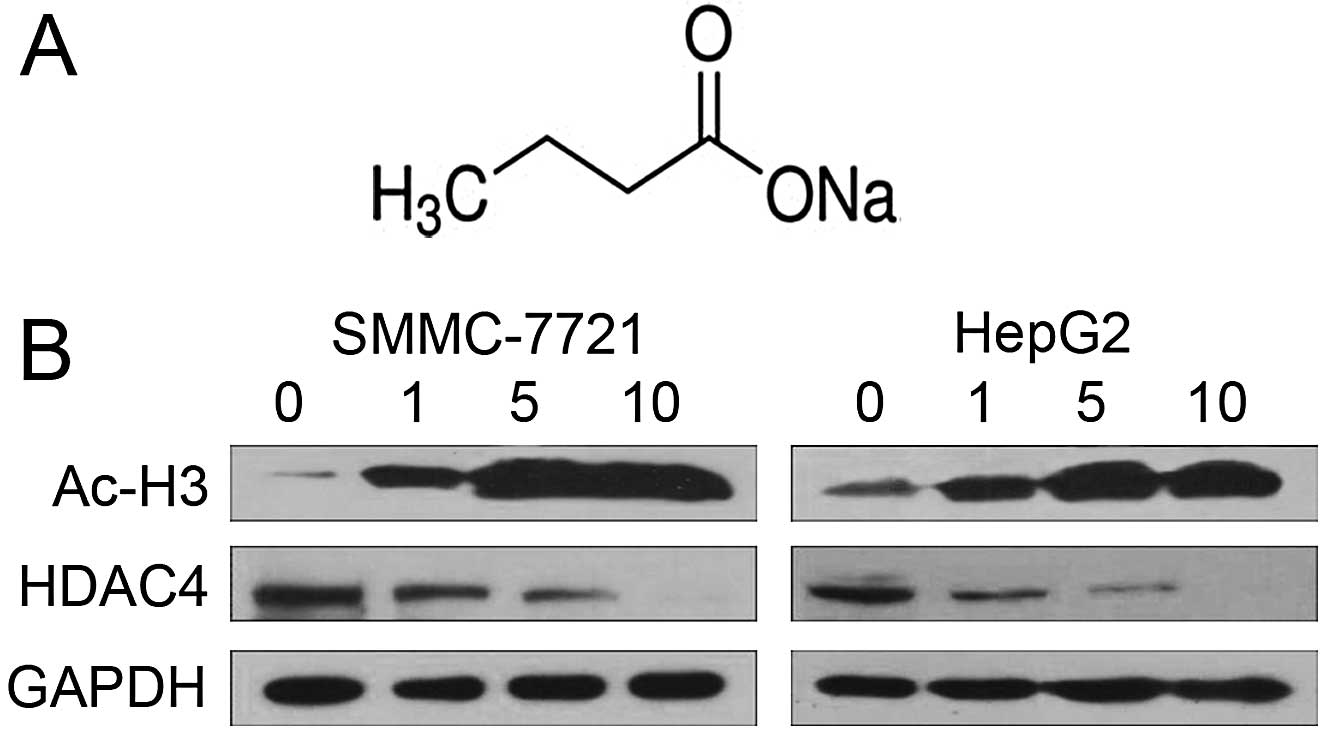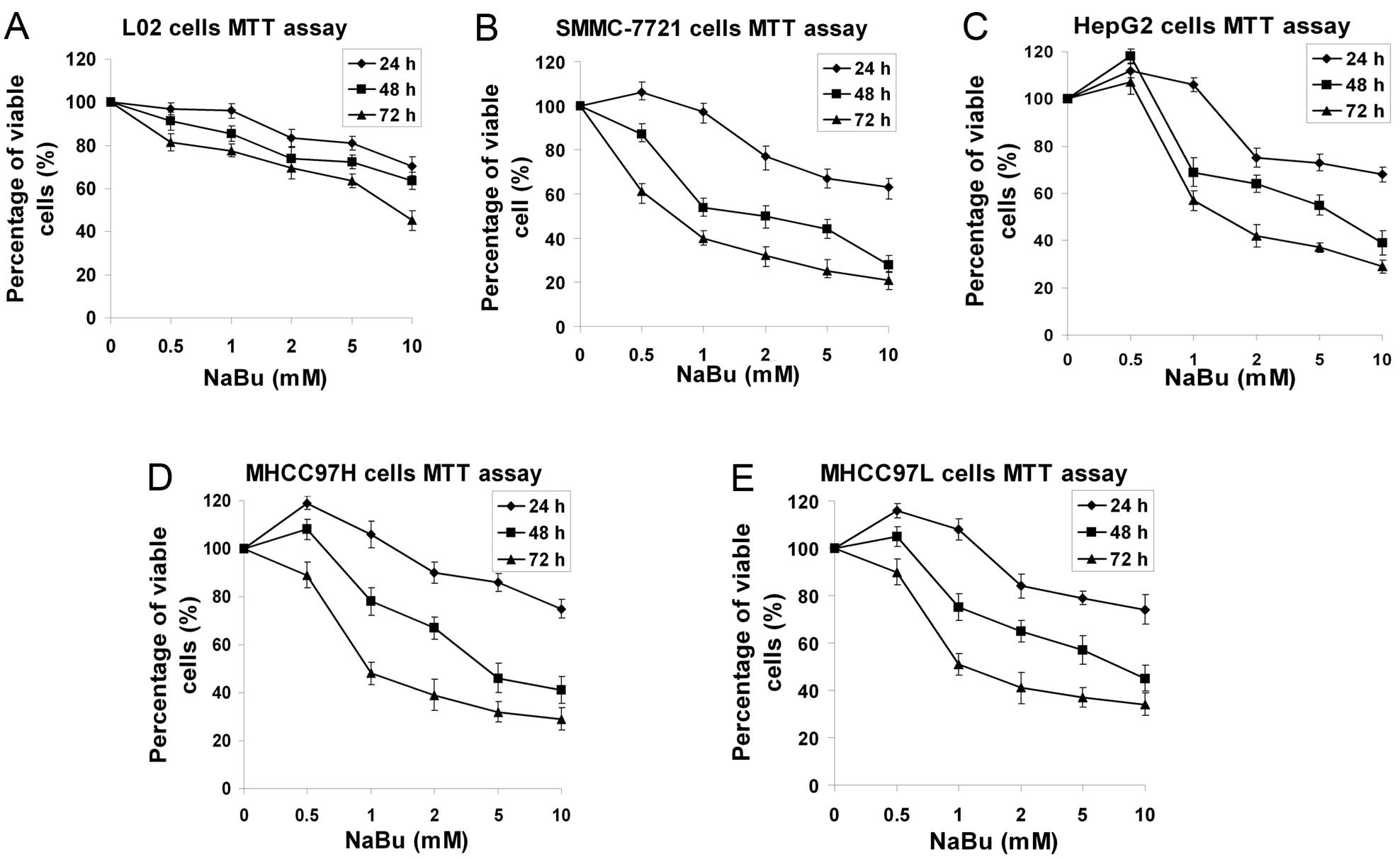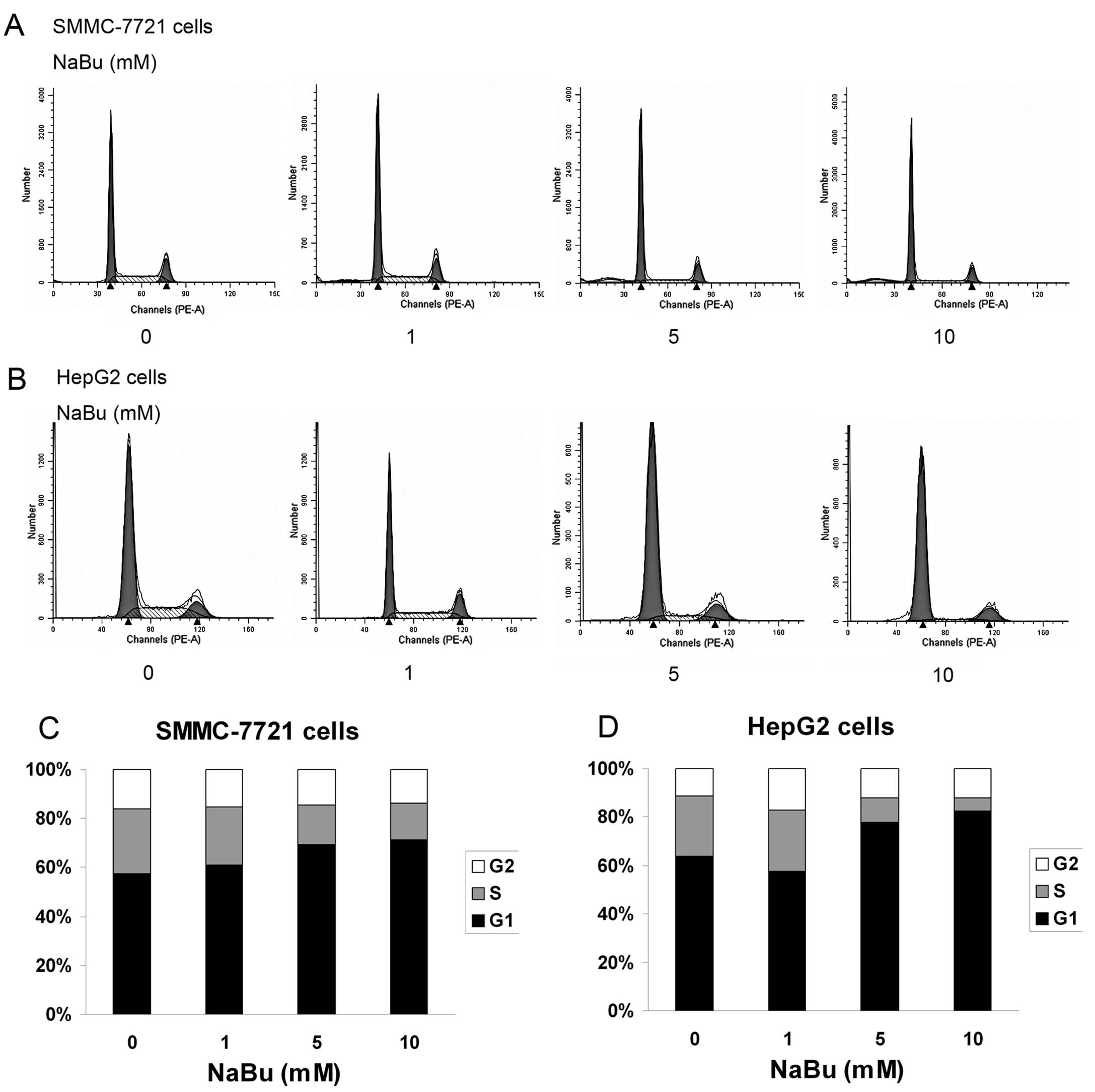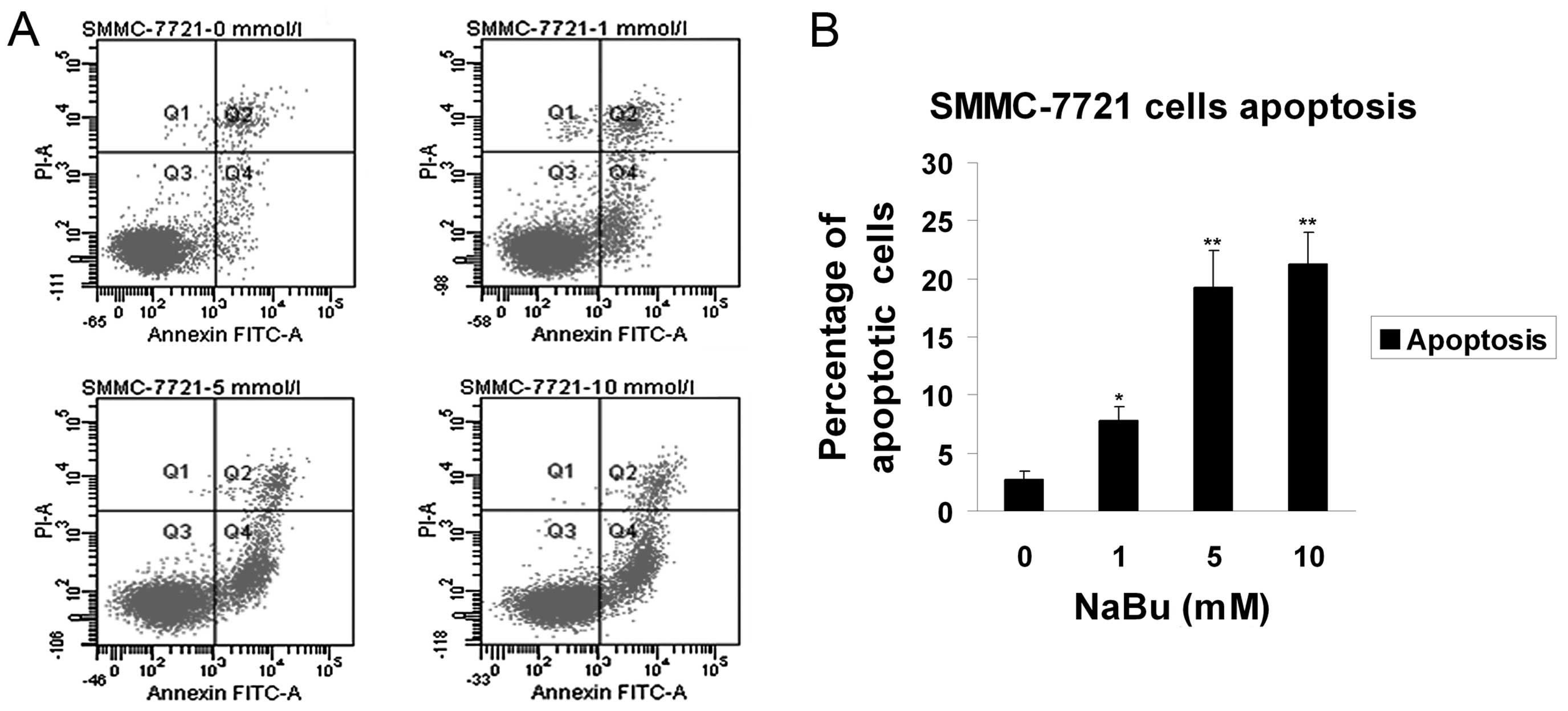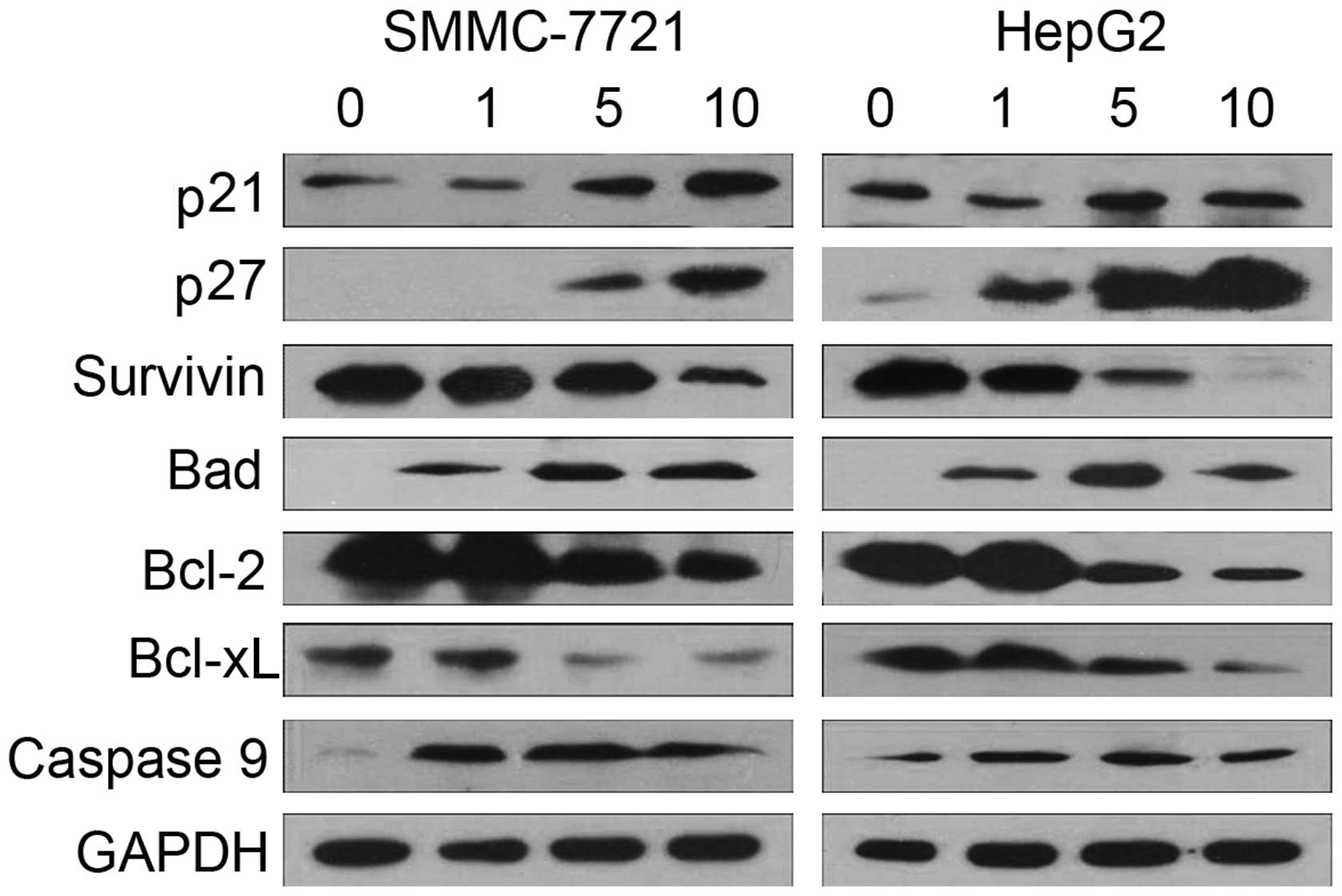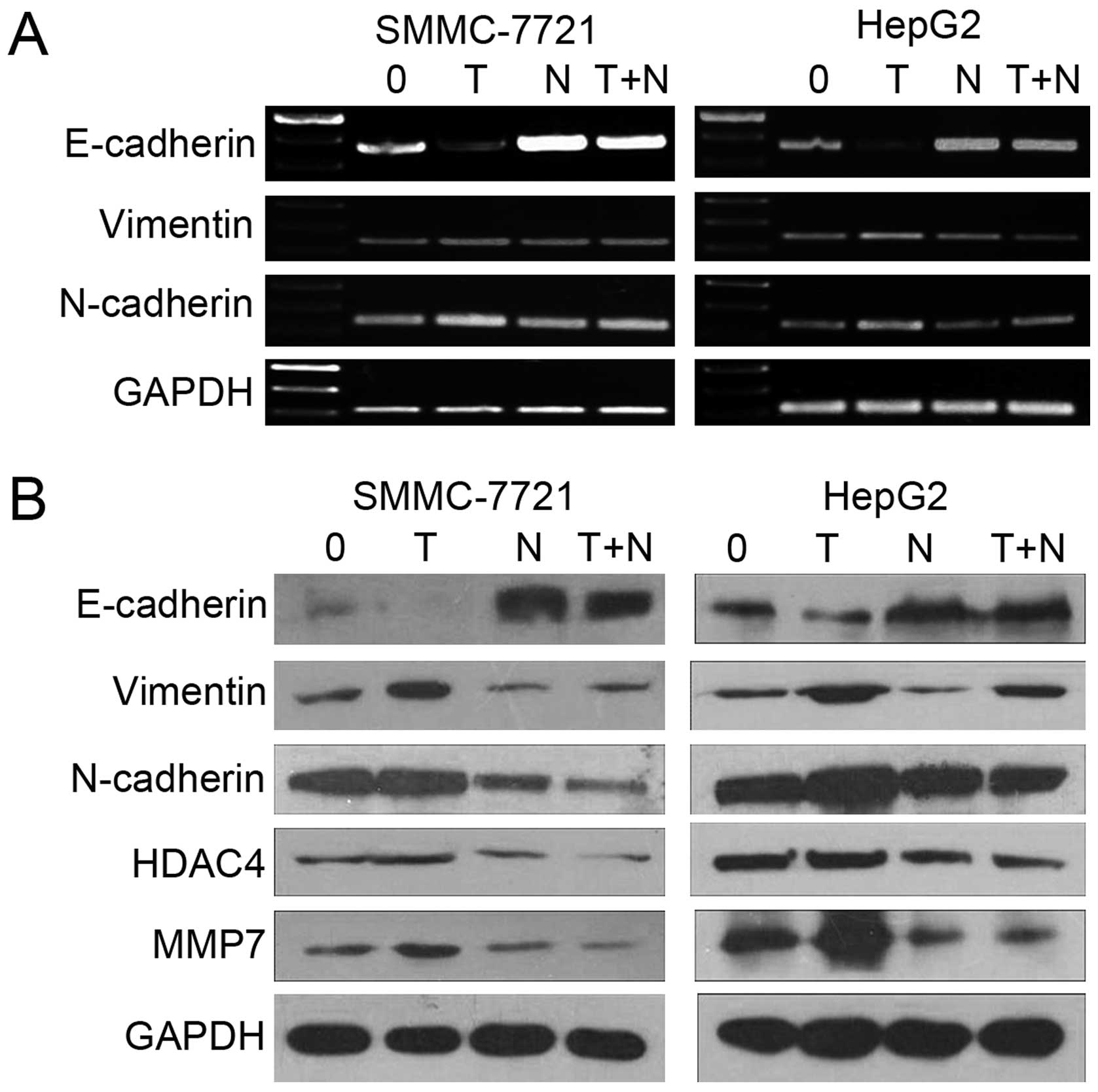Anticancer effects of sodium butyrate on hepatocellular carcinoma cells in vitro
- Authors:
- Published online on: February 22, 2013 https://doi.org/10.3892/ijmm.2013.1285
- Pages: 967-974
Abstract
Introduction
Hepatocellular carcinoma (HCC) is one of the most common malignancies worldwide. Liver cancer in males is the fifth most frequently diagnosed cancer worldwide and the second most frequent cause of cancer-related mortality (1). Half of these cases and deaths have been estimated to occur in China. It is also the second greatest cause of cancer-related deaths in China (2). Tumor metastasis is considered to be the main determinant in HCC patient survival; however, the mechanisms involved have not yet been fully elucidated. Epithelial to mesenchymal transition (EMT) is an important step in the invasion and metastasis of cancer and transforming growth factor-β1 (TGF-β1) induces the progression of cancer through EMT. It has been shown that TGF-β1 plays a key role in modulating HCC aggressiveness by triggering EMT (3). Therefore, effective drugs targeting the TGF-β1 signaling pathways that correlate with EMT have the potential to provide a novel approach for the prevention and treatment of the early metastasis of HCC and may thus improve prognosis. Histone deacetylases (HDACs) are enzymes that catalyze the removal of acetyl from lysine residues in histones and other proteins, causing gene transcriptional repression and subsequent changes in signaling events. Eighteen HDACs, which have been shown to have unique functions, have been identified in mammals. Previous studies have demonstrated that HDAC inhibitors suppress cancer cell invasion and metastasis by regulating the subsequent gene transcription that causes invasion and migration (4,5). However, it is unclear as to which members of the HDAC family are associated with the regulation of cancer cell invasion and migration. HDAC4, a member of class II HDACs, has been shown to play an important role in regulating cell migration and invasion in ovarian cancer cells (6). A high HDAC4 expression has also been observed in liver cancer (7,8); however, it remains unclear whether HDAC4 participates in EMT in HCC cells.
Short chain fatty acids (SCFAs) have been reported as effective HDAC inhibitors with multiple effects on cell growth, differentiation and apoptosis in a variety of cancer cells (9,10). Sodium butyrate (NaBu), one of the sodium salts of SCFAs, is naturally produced in the colonic lumen as a consequence of the microbial degradation of dietary fibers (11). As an HDAC inhibitor, first reported in 1978 (12), NaBu has shown great potential in cancer treatment and prevention (13). It has been demonstrated that NaBu can cause cell cycle arrest, trigger cell apoptosis and induce cell differentiation in multiple cancer cells lines derived from the colon, breast, liver, etc. (14–18). Mechanism analysis has further demonstrated that NaBu selectively regulates gene expression by inducing chromatin hyperacetylation, which contributes to its diverse physiological roles. The potential effects of NaBu specifically on HCC have been investigated in a number of studies. It has been reported that NaBu suppresses cell growth and reduces the invasive ability of HCC cells (19,20). However, the mechanisms responsible for these effects remain largely illusive. This prompted us to investigate the effect of NaBu on TGF-β1-induced EMT, which may provide a reasonable explanation for the inhibition of tumor invasion and metastasis.
In the present study, we examined the possible role of NaBu in the regulation of HCC cell proliferation, apoptosis, migration and invasion. Our results show that NaBu inhibits of the proliferation, promotes apoptosis and suppresses the invasion of SMMC-7721 and HepG2 cells by inhibiting TGF-β1-induced EMT, suggesting that NaBu may have therapeutic value in HCC.
Materials and methods
Cell lines and cell culture
The human HCC cell lines, HepG2, SMMC-7721, and the L02 human normal liver cell line were purchased from the China Center for Type Culture Collection (CCTCC). The MHCC97H and MHCC97L cell lines were purchased from the Liver Cancer Institute of Fudan University (Shanghai, China). The HepG2, MHCC97H, MHCC97L and L02 cells were cultured in Dulbecco’s modified Eagle’s medium (DMEM; Gibco), while the SMMC-7721 cells were cultured in RPMI-1640 medium (Gibco) supplemented with 10% fetal bovine serum (FBS; Gibco), 100 U/ml of penicillin and 100 μg/ml of streptomycin in a 5% CO2 incubator (Thermo Scientific, Barrington, IL, USA).
Antibodies and reagents
The anti-GAPDH antibody used to evaluate the equal loading of protein samples was purchased from Abmart, Inc., Shanghai, China. E-cadherin antibodies were purchased from Cell Signaling Technology (Danvers, MA, USA). Vimentin and N-cadherin antibody were purchased from Abcam (Cambridge, UK). p21, p27, survivin, Bad, Bcl-2, Bcl-xL, caspase-9 and HDAC4 antibodies were purchased from Signalway Antibody Co., Ltd., College Park, MD, USA. Matrix metalloproteinase (MMP)7 antibody was purchased from RayBiotech (Norcross, GA, USA). The goat anti-mouse and goat anti-rabbit HRP-anchored secondary antibodies were purchased from Zhongshan Goldenbridge Biotechnology, Beijing, China. NaBu was purchased from Sigma-Aldrich (St. Louis, MO, USA), diluted with PBS to a concentration of 100 mM and then stored at 4°C until use. Recombinant human TGF-β1 was purchased from PeproTech (Rocky Hill, NJ, USA), and reconstituted at 10 μg/ml in sterile PBS containing 0.1% bovine serum albumin. 3-(4,5-Dimethylthiazol-2-yl)-2,5-diphenyltetrazolium bromide (MTT) assay was purchased from Fluka, Inc., USA. Annexin V-FITC apoptosis detection kit, propidium iodide (PI) staining solution and Matrigel were from BD Biosciences (Franklin Lakes, NJ, USA). RPMI-1640, DMEM and FBS were from Gibco/Life Technologies, Paisley, UK.
Cell viability assay
The effect of NaBu treatment on the viability of different cells was measured by MTT assay based on the ability of live cells to cleave the tetrazolium ring to a molecule that absorbs at 570 nm. Cells (1×104) 200 μl/well were grown in 96-well plates for 24, 48 and 72 h. The cells were further incubated with various concentrations of NaBu in DMEM or RPMI-1640 supplemented with 10% FBS. After 24, 48 and 72 h, 20 μl MTT solution (5 mg/ml) were added to each well, and the cells were further incubated at 37°C for 4 h; subsequently, 150 μl of buffered DMSO were added to each well. The absorbance was recorded on a microplate reader at a wavelength of 570 nm. Untreated cells were used as the controls. At least 3 replicate experiments were performed with 6 wells per concentration.
Cell cycle and apoptosis analysis by flow cytometry
Cell cycle analyses were carried out using flow cytometry. SMMC-7721 and HepG2 cells (1×106) were seeded in 6-well plates and allowed to attach overnight. Growing cells were treated with various concentrations of NaBu and harvested by 0.25% trypsin (Beyotime Institute of Biotechnology, Haimen, China) at the indicated time points. The cells were then washed twice with PBS, centrifuged at 1,000 rpm for 5 min, and the cells were washed again with PBS, treated with 100 μg/ml RNase, and stained with 50 μg/ml PI (BD Biosciences, USA) in the dark. Flow cytometry analyses were carried out on a FACScalibur instrument using the ModFit program (Becton-Dickinson, Franklin Lakes, NJ, USA). Apoptosis was detected with an Annexin V-FITC/PI detection kit (BD Biosciences). Cells (10,000) per sample were analyzed with a FACScalibur flow cytometer.
Wound healing assay
Cells were seeded into a 6-well tissue culture dish and allowed to grow to 90% confluency in complete medium. Cell monolayers were wounded by a plastic tip (200 μl tip) that touched the plate as previously described (21). Wounded monolayers were then washed 3 times with medium to remove the cell debris and incubated in medium with various concentrations of NaBu for 24, 48, 72 or 96 h, then the distance of cell migration was determined under an inverted microscopy at various time points. The relative migration distance was calculated by the following formula: relative migration distance (%) = average migration distance of treated group/average migration distance of untreated group ×100%. Experiments were repeated at least 3 times.
Transwell assay
The invasion assays were carried out using Transwell chamber with 6.5 mm diameter polycarbonate filters (8 μm pore size; Corning Costar, Rochester, NY, USA) coated with Matrigel (BD Biosciences) in a standard manner. Cells were trypsinized and suspended at a final concentration of 1×106 cells/ml in DMEM or RPMI-1640 medium. Before seeding, the cells were treated with various concentrations of NaBu for 24 h. Cell suspension was loaded into each of the upper wells. Fetal calf serum (5%) was used as a chemoattractant in the lower chambers. Before seeding, the cells were incubated for 36 h at 37°C in an atmosphere of 5% CO2/95% air, followed by a further incubation under the same conditions; all of the non-invaded cells were then removed from the upper face of the Transwell membrane with a cotton swab. The invaded cells were fixed with 100% methanol and then stained with crystal violet (Nanjing Sunshine Biotechnology, Nanjing, China). The invaded cells were counted microscopically. Ten fields were counted for each assay.
Reverse transcription PCR
Total RNA was isolated using TRIzol reagent (Invitrogen, Carlsbad, CA, USA) according to the manufacturer’s instructions. Complementary DNA was synthesized using a reverse transcription reagent kit (Fermentas, Burlington, ON, Canada). Subsequently, cDNA was used to perform PCR using specific gene primers under the condition of 95°C (3 min), followed by 35 cycles of 94°C (30 sec), 48°C for vimentin, 52°C for N-cadherin and 58°C for E-cadherin, GAPDH (30 sec) and 72°C (1 min), then finally 72°C (5 min). GAPDH was employed as an endogenous control to normalize the amount of total mRNA in each sample. The PCR products were examined by 1.5% agarose gel electrophoresis, and the abundance of each mRNA was detected. The reverse transcription PCR reactions were performed in triplicate. The primer sequences were as follows: E-cadherin sense, 5′-CGTAGCAGTGACGAATGTGGTAC-3′ and antisense, 5′-AACTGGAGAACCATTGTCTGTAGC-3′; vimentin sense, 5′-CCAAACTTTTCCTCCCTGAACC-3′ and antisense, 5′-GTGATGCTGAGAAGTTTCGTTGA-3′; N-cadherin sense, 5′-AGCCAACCTTAACTGAGGAGT-3′ and antisense, 5′-GGCAAGTTGATTGGAGGGATG-3′; GAPDH sense, 5′-ATGGGGAAGGTGAAGGTCG-3′ and antisense, 5′-GGGTCATTGATGGCAACAATATC-3′.
Western blot analysis
For the western blot analysis, cells were collected and lysed with 1% SDS to break down the membranes, and subsequently, whole proteins were heated at 95°C for 10 min to inactivate the proteases. The samples were centrifuged for 15 min, and the protein concentration of each sample was assessed using BCA reagent (Beyotime Institute of Biotechnology). Equivalent amounts of protein were loaded into each lane and separated using SDS-PAGE on 10 or 12% gels (Bio-Rad, Hercules, CA, USA) and then transferred onto PVDF membranes (Millipore, Billerica, MA, USA) by wet transfer (Bio-Rad) and blocking with 5% non-fat milk for 1 h. Finally, the membranes were incubated with the specific primary antibody overnight at 4°C. After washing the membranes with Tris-buffered saline containing Tween-20 (TBST) 3 times for 10 min each, the membranes were incubated with HRP-conjugated secondary antibodies for 1 h and then washed 3 times with TBST again. The target protein bands were visualized using an ECL reagent kit (Thermo Scientific) and exposed to an X-ray film (Kodak).
Statistical analysis
All values are expressed as the means ± SE. One-way ANOVA followed by the LSD t-test and SNK-q test were used to compare differences between groups. A two-sided P-value <0.05 was considered to indicate a statistically significant difference.
Results
Effects of NaBu on Ac-H3 and HDAC4 expression in HCC cells
As an HDAC inhibitor, NaBu was able to induce histone hyperacetylation. The chemical structure of NaBu is shown in Fig. 1A. In our study, we detected the activity of NaBu in regulating histone H3 acetylation. SMMC-7721 and HepG2 cells were treated with various concentrations NaBu for 24 h before being harvested and subjected to western blot analysis using specific acetylated histone H3 (Ac-H3) antibody. NaBu at a concentration of 0 to 10 mM (mmol/l) induced H3 acetylation in a dose-dependent manner (Fig. 1B). Western blot analysis using specific HDAC4 antibodies was performed to further analyze the expression of HDAC4 following NaBu treatment. The highly expressed HDAC4 protein in SMMC-7721 and HepG2 cells was significantly downregulated following NaBu treatment in a concentration-dependent manner.
Different inhibitory effects of NaBu on cell proliferation
To determine the effects of NaBu on HCC cells, 4 HCC cell lines, SMMC-7721, HepG2, MHCC97H and MHCC97L, were used in this study. The L02 normal liver cell line was also used. All cells were exposed to various concentrations of NaBu ranging from 0 to 10 mM for 24, 48 and 72 h, and then cell growth curves were recorded using MTT assay. NaBu significantly inhibited the proliferation of SMMC-7721, HepG2, MHCC97H and MHCC97L cells following treatment with NaBu at high concentrations (Fig. 2B-E). Surprisingly, low concentrations of NaBu (0.5 and 1 mM) had no apparent inhibitory effect on the cells at 24 h. However, at 48 or 72 h, low concentrations of NaBu inhibited hepatoma cell proliferation. Furthermore, to compare these effects, the L02 normal liver cell line was also treated with NaBu. We found that the inhibitory effect of NaBu on L02 cells was inferior to that on HCC cells (Fig. 2A). These data suggest that the same concentration of NaBu exerted a stronger inhibitory effect on hepatoma cells than L02 cells, showing low cytotoxicity against normal liver cells at 24 h after treatment at a low dose. These results demonstrate that low concentrations of NaBu have low cytotoxic effects on normal liver cells in the treatment of HCC.
Effects of NaBu on cell cycle distribution
As cell cycle progression is a critical determinant of cell growth, FACS analysis was performed to determine whether NaBu can induce cell cycle arrest. Compared to the untreated control groups, the SMMC-7721 and HepG2 cells treated with NaBu had an increased percentage of cells arresting in the G1 phase at 24 h. In addition, the S phase was significantly inhibited by treatment with 5 and 10 mM NaBu. These data suggest that NaBu induces cell cycle arrest in human SMMC-7721 and HepG2 cells (Fig. 3).
Effects of NaBu on cell apoptosis
Apoptosis induced by various concentrations of NaBu in SMMC-7721 cells was analyzed using Annexin V/PI staining. Compared with the control group, the proportion of apoptotic cells increased followed by treatment with various concentrations of NaBu (0, 1, 5 and 10 mM) for 24 h, with early apoptotic rates of 2.7, 7.8, 19.3 and 21.3%, respectively. The percentage of live cells was 93.9, 87.2, 76.1 and 75.0%, respectively (Fig. 4). These results indicated that NaBu induced the apoptosis of SMMC-7721 cells in a concentration and time-dependent manner. In conclusion, NaBu has the ability to exert significant inhibitory effects on a variety of HCC cells based on the regulation of the cell cycle and the induction of apoptosis.
Effects of NaBu on the expression of cell cycle- and apoptosis-related proteins
The expression levels of cell cycle- and apoptosis-related proteins (p21, p27, survivin, Bad, Bcl-2, Bcl-xL and caspase-9) were further investigated by western blot analysis using specific antibodies after 24 h of NaBu treatment. As shown in Fig. 5, high concentrations of NaBu caused a significant increase in p21 and p27 expression; however, 1 mM NaBu slightly reduced p21 expression. Survivin is considered to be involved not only in cell cycle regulation, but also in the inhibition of apoptosis. We observed a significant reduction in survivin protein expression following treatment with NaBu. Members of the Bcl-2 family of proteins are critical regulators of the intrinsic apoptotic pathway. In order to determine whether NaBu inhibits Bcl-2 family proteins, Bcl-2, Bcl-xL and Bad expression was also detected by western blot analysis. We found that NaBu suppressed the expression of the anti-apoptotic proteins, Bcl-2 and Bcl-xL, in a dose-dependent manner; however, treatment with NaBu increased pro-apoptotic protein Bad expression in SMMC-7721 and HepG2 cells. Following NaBu treatment, caspase-9 expression was also upregulated, suggesting that the apoptotic process was activated in hepatoma cells. These results provide a possible mechanism responsible for the inhibitory effect of NaBu on the growth of HCC cells.
Effects of NaBu on HCC cell migration and invasion
To further analyze the effects of NaBu on the ability of cells to migrate and invade, wound healing and Transwell assays were performed. The wound closure was slowed down in the presence of NaBu in SMMC-7721 and HepG2 cells, as shown by wound healing assay. High concentrations NaBu significantly decreased the cell migration distance (Fig. 6A and B). Furthermore, treatment with NaBu dramatically reduced the invasive ability of the SMMC-7721 and HepG2 cells, as compared with the untreated control group, as shown by Transwell assays (Fig. 6C). Taken together, these data confer that NaBu significantly inhibits the cell migration/invasion of HCC cells.
Inhibitory effects of NaBu on TGF-β1-induced EMT
EMT has been associated with tumor cell migration and invasion. Thus, we further examined the effects of NaBu on EMT. Reverse transcription PCR and western blot analysis were employed to determine whether NaBu exerts its effects by antagonizing TGF-β1-induced EMT. E-cadherin is a universal epithelial marker in the EMT process that plays a key role in the maintenance of cellular integrity at the cell-cell junction. In the present study, NaBu clearly upregulated E-cadherin mRNA and protein expression and aborted the repression induced by TGF-β1 (Fig. 7A). Vimentin and N-cadherin are often used to identify mesenchymal cells and the process of EMT. MMP7, an extracellular matrix protein, is also considered be related to EMT. Further experiments showed that NaBu aborted the TGF-β1-induced upregulation of vimentin, N-cadherin, MMP7 and HDAC4 in the SMMC-7721 and HepG2 cells (Fig. 7B). Taken together, these data suggest that NaBu inhibits TGF-β1-induced EMT in human hepatoma cells, suggesting that NaBu exerts an inhibitory effect on the early metastasis HCC cells.
Discussion
The modification of epigenetic markers, such as DNA methylation or histone acetylation by pharmacological agents has been hypothesized to play a role in cancer progression (22). Epigenetic regulation of gene transcription by histone acetylation has been shown to be a promising new therapeutic target in oncology (22–24). Different patterns of HDAC overexpression have been demonstrated for a variety of human cancers (25–28). HDAC4, a class II HDAC, has been associated with a number of diseases, such as neurodegeneration (29), diabetes (30) and cancer process (6,31). A recent study showed that HDAC4 mRNA was upregulated in human HCC tissues compared with paired adjacent non-cancerous hepatic tissues, as analyzed by real-time PCR (7), suggesting HDAC4 plays a role in HCC progression. An effective inhibitor of HDAC4 may therefore prove useful in the treatment of HCC. NaBu, a HDAC inhibitor, inhibits the majority of HDACs, apart from class III HDACs and the class II HDACs, HDAC6 and HDAC10 (16). In the current study, we observed that NaBu downregulated HDAC4 expression in an dose-dependent manner in the SMMC-7721 and HepG2 cells, proving NaBu is a potent inhibitor of HDAC4 in HCC cells.
As a HDAC inhibitor, NaBu affects cell behavior through the transcriptional regulation of gene expression. Epigenetic markers, such as histone acetylation and chromatin plasticity may be modified upon NaBu treatment. In present study, NaBu induced histone H3 acetylation in a dose-dependent manner. This was observed in the HepG2 cells, providing a possible mechanism for gene expression regulation, as described above. We then analyzed the effect of NaBu on the L02 normal liver cell line and on 4 HCC cell lines by MTT. We found that NaBu exerted a significant inhibitory effect on the HCC cell lines treated with high concentrations of NaBu. However, no potent inhibitory effect was observed in the normal liver cell line following treatment with low concentrations of NaBu. This indicates that NaBu may exert weaker cytotoxic effects on normal liver cells compared to HCC cells.
We demonstrated that NaBu is highly effective in suppressing the growth of HCC cells. The arrest in the G1 phase of the cell cycle and the reduction in the S phase cell population is likely to account for this effect. The molecular mechanism involved was further examined by western blot analysis. p21 and p27 are cyclin-dependent kinase inhibitors that play important roles in blocking the cell cycle in the G1 phase (32). The protein levels of p21 and p27 were upregulated following treatment with NaBu at high concentrations, suggesting that this upregulation is one of the possible mechanisms by which NaBu inhibits the growth of HCC cells. Apoptosis is an active gene-directed mechanism of cellular suicide, important for the development and homeostasis of the multicellular organism. Specific therapies have been designed to enhance the susceptibility of human cancer cells to undergo apoptosis. In this study, we showed that NaBu dramatically and significantly increased the number of early apoptotic cells in the SMMC-7721 cell line. This effect was associated with a decrease in the levels of the anti-apoptotic proteins, survivin, Bcl-2, Bcl-xL and an increase in the levels of the pro-apoptotic proteins, Bad and caspase-9. The present findings raise the possibility that NaBu may prove particularly effective in the treatment of HCC. Thus, NaBu exhibits anti-proliferative activity and potently induces apoptosis in human liver cancer cells.
Tumor invasion and metastasis are the major characteristics of aggressive phenotypes of a variety of human cancers, and, therefore, the major causes of cancer-related mortality. HDAC inhibitors have been shown to be inhibitors of migration and invasion (6,33). In this study, wound healing and Transwell assays showed that a significant decrease in HCC cell migration and invasion occurred following treatment with NaBu at various concentrations. However, the detailed mechanisms involved remain unclear. EMT has been associated with tumor invasion and metastasis (34,35). TGF-β1 can induce typical EMT in a number of cells, including hepatocytes and HCC cells, which has been implicated in hepatic fibrosis, cirrhosis, and HCC invasion and metastasis (36–39). It has been reported that another HDAC inhibitor, trichostatin A (TSA), suppresses the TGF-β1-induced EMT in hepatocytes (40) and renal epithelial cells (41). However, it remains unclear whether NaBu participates in TGF-β1-induced EMT in HCC cells. Thus, we further detected EMT-related gene expression following treatment with 10 ng/ml TGF-β1 and/or 1 mM NaBu. We observed no significant cytotoxic effects on normal liver cells treated with 1 mM NaBu for 24 h. In the present study, we found that NaBu abolished the downregulation of E-cadherin mRNA and protein expression induced by TGF-β1 in SMMC-7721 and HepG2 cells. The mesenchymal markers, N-cadherin and vimentin, were upregulated by TGF-β1; however, NaBu suppressed this process. Taken together, these results demonstrate that NaBu prevented TGF-β1-induced EMT, thus providing a possible mechanism responsible for its inhibitory effect on migration and invasion. A recent study (6) revealed that apicidin, a HDAC inhibitor, inhibited human ovarian cancer cell migration via HDAC4 silencing, showing that HDAC4 may be involved in EMT in cancer. In this study, the HDAC4 inhibitor, NaBu, inhibited TGF-β1-induced EMT; therefore, we propose that HDAC4 may also participate in TGF-β1-induced EMT. In our study, we found that HDAC4 levels were elevated following treatment with TGF-β1. The upregulated HDAC4 expression was suppressed following treatment with NaBu in the SMMC-7721 and HepG2 cells. It has been substantiated that the TGF-β1 signaling pathway can activate MMP7 expression (42–44) which is able to cleave and shed digestive E-cadherin (42). In our study, we found that NaBu suppressed the TGF-β1-induced upregulation of MMP7 expression in both HCC cells, providing a new mechanism responsible for the inhibitory effect of NaBu on TGF-β1-induced EMT. Taken together, our results showed that NaBu suppressed cell migration and invasion by inhibiting TGF-β1-induced EMT, in which HDAC4 and MMP7 may be involved.
In conclusion, our study demonstrates the inhibitory effects of the HDAC inhibitor, NaBu. These effects include the inhibition of cell proliferation, cell cycle arrest, the regulation of TGF-β1-induced EMT and the inhibition of cell migration and invasion in HCC cells. These data suggest that such activities serve as anti-tumor mechanisms of the HDAC inhibitor, NaBu, in which HDAC4 and MMP7 may be involved. However, further research is required. In future studies, we aim to investigate the role of NaBu in animals to verify whether there is a similar anticancer effect. In conclusion, NaBu exerts anticancer effects on HCC cells in vitro; thus, NaBu may provide a novel strategy for the treatment of HCC.
Acknowledgements
This study was supported by the Science and Technology Program of the Health Department of Jiangsu Province (H201009), the Science and Technology Innovation Foundation of Nanjing Medical University (2010NJMUZ054) and the Program of Science and Technology of Nanjing (201104029). The funding sources had input into the design of this study, the collection, analysis and interpretation of the data.
References
|
Jemal A, Bray F, Center MM, Ferlay J, Ward E and Forman D: Global cancer statistics. CA Cancer J Clin. 61:69–90. 2011. View Article : Google Scholar | |
|
Tang ZY: Small hepatocellular carcinoma: current status and prospects. Hepatobiliary Pancreat Dis Int. 1:349–353. 2002.PubMed/NCBI | |
|
Giannelli G, Bergamini C, Fransvea E, Sgarra C and Antonaci S: Laminin-5 with transforming growth factor-beta1 induces epithelial to mesenchymal transition in hepatocellular carcinoma. Gastroenterology. 129:1375–1383. 2005. View Article : Google Scholar : PubMed/NCBI | |
|
Marks PA, Richon VM, Miller T and Kelly WK: Histone deacetylase inhibitors. Adv Cancer Res. 91:137–168. 2004. View Article : Google Scholar : PubMed/NCBI | |
|
Jeon HW and Lee YM: Inhibition of histone deacetylase attenuates hypoxia-induced migration and invasion of cancer cells via the restoration of RECK expression. Mol Cancer Ther. 9:1361–1370. 2010. View Article : Google Scholar : PubMed/NCBI | |
|
Ahn MY, Kang DO, Na YJ, et al: Histone deacetylase inhibitor, apicidin, inhibits human ovarian cancer cell migration via class II histone deacetylase 4 silencing. Cancer Lett. 325:189–199. 2012. View Article : Google Scholar : PubMed/NCBI | |
|
Yuan JH, Yang F, Chen BF, et al: The histone deacetylase 4/SP1/microrna-200a regulatory network contributes to aberrant histone acetylation in hepatocellular carcinoma. Hepatology. 54:2025–2035. 2011. View Article : Google Scholar : PubMed/NCBI | |
|
Zhang J, Yang Y, Yang T, et al: microRNA-22, downregulated in hepatocellular carcinoma and correlated with prognosis, suppresses cell proliferation and tumourigenicity. Br J Cancer. 103:1215–1220. 2010. View Article : Google Scholar : PubMed/NCBI | |
|
Prasad KN: Butyric acid: a small fatty acid with diverse biological functions. Life Sci. 27:1351–1358. 1980. View Article : Google Scholar : PubMed/NCBI | |
|
D’Argenio G and Mazzacca G: Short-chain fatty acid in the human colon. Relation to inflammatory bowel diseases and colon cancer. Adv Exp Med Biol. 472:149–158. 1999.PubMed/NCBI | |
|
Bergman EN: Energy contributions of volatile fatty acids from the gastrointestinal tract in various species. Physiol Rev. 70:567–590. 1990.PubMed/NCBI | |
|
Candido EP, Reeves R and Davie JR: Sodium butyrate inhibits histone deacetylation in cultured cells. Cell. 14:105–113. 1978. View Article : Google Scholar : PubMed/NCBI | |
|
Fung KY, Cosgrove L, Lockett T, Head R and Topping DL: A review of the potential mechanisms for the lowering of colorectal oncogenesis by butyrate. Br J Nutr. 108:820–831. 2012. View Article : Google Scholar : PubMed/NCBI | |
|
Archer SY, Meng S, Shei A and Hodin RA: p21(WAF1) is required for butyrate-mediated growth inhibition of human colon cancer cells. Proc Natl Acad Sci USA. 95:6791–6796. 1998. View Article : Google Scholar : PubMed/NCBI | |
|
Fung KY, Brierley GV, Henderson S, et al: Butyrate-induced apoptosis in HCT116 colorectal cancer cells includes induction of a cell stress response. J Proteome Res. 10:1860–1869. 2011. View Article : Google Scholar : PubMed/NCBI | |
|
Davie JR: Inhibition of histone deacetylase activity by butyrate. J Nutr. 133(Suppl 7): 2485S–2493S. 2003.PubMed/NCBI | |
|
Sun B, Liu R, Xiao ZD and Zhu X: c-MET protects breast cancer cells from apoptosis induced by sodium butyrate. PLoS One. 7:e301432012. View Article : Google Scholar : PubMed/NCBI | |
|
Tsutsumi T, Ido A, Nakao K, et al: Reciprocal regulation of alpha-fetoprotein and albumin gene expression by butyrate in human hepatoma cells. Gastroenterology. 107:499–504. 1994.PubMed/NCBI | |
|
Yamamoto H, Fujimoto J, Okamoto E, Furuyama J, Tamaoki T and Hashimoto-Tamaoki T: Suppression of growth of hepatocellular carcinoma by sodium butyrate in vitro and in vivo. Int J Cancer. 76:897–902. 1998. View Article : Google Scholar : PubMed/NCBI | |
|
Kaneko F, Saito H, Saito Y, et al: Down-regulation of matrix-invasive potential of human liver cancer cells by type I interferon and a histone deacetylase inhibitor sodium butyrate. Int J Oncol. 24:837–845. 2004.PubMed/NCBI | |
|
Lok GT, Chan DW, Liu VW, et al: Aberrant activation of ERK/FOXM1 signaling cascade triggers the cell migration/invasion in ovarian cancer cells. PLoS One. 6:e237902011. View Article : Google Scholar : PubMed/NCBI | |
|
Dawson MA and Kouzarides T: Cancer epigenetics: from mechanism to therapy. Cell. 150:12–27. 2012. View Article : Google Scholar : PubMed/NCBI | |
|
Perego P, Zuco V, Gatti L and Zunino F: Sensitization of tumor cells by targeting histone deacetylases. Biochem Pharmacol. 83:987–994. 2012. View Article : Google Scholar : PubMed/NCBI | |
|
Ganesan A, Nolan L, Crabb SJ and Packham G: Epigenetic therapy: histone acetylation, DNA methylation and anti-cancer drug discovery. Curr Cancer Drug Targets. 9:963–981. 2009. View Article : Google Scholar : PubMed/NCBI | |
|
Quint K, Agaimy A, Di Fazio P, et al: Clinical significance of histone deacetylases 1, 2, 3, and 7: HDAC2 is an independent predictor of survival in HCC. Virchows Arch. 459:129–139. 2011. View Article : Google Scholar : PubMed/NCBI | |
|
Francisco R, Perez-Perarnau A, Cortes C, Gil J, Tauler A and Ambrosio S: Histone deacetylase inhibition induces apoptosis and autophagy in human neuroblastoma cells. Cancer Lett. 318:42–52. 2012. View Article : Google Scholar : PubMed/NCBI | |
|
Zhang JX, Li DQ, He AR, et al: Synergistic inhibition of hepatocellular carcinoma growth by cotargeting chromatin modifying enzymes and poly (ADP-ribose) polymerases. Hepatology. 55:1840–1851. 2012. View Article : Google Scholar : PubMed/NCBI | |
|
Wang J, Kim TH, Ahn MY, et al: Sirtinol, a class III HDAC inhibitor, induces apoptotic and autophagic cell death in MCF-7 human breast cancer cells. Int J Oncol. 41:1101–1109. 2012.PubMed/NCBI | |
|
Li J, Chen J, Ricupero CL, et al: Nuclear accumulation of HDAC4 in ATM deficiency promotes neurodegeneration in ataxia telangiectasia. Nat Med. 18:783–790. 2012. View Article : Google Scholar : PubMed/NCBI | |
|
Weems JC, Griesel BA and Olson AL: Class II histone deacetylases downregulate GLUT4 transcription in response to increased cAMP signaling in cultured adipocytes and fasting mice. Diabetes. 61:1404–1414. 2012. View Article : Google Scholar : PubMed/NCBI | |
|
Reddy SD, Pakala SB, Molli PR, et al: Metastasis-associated protein 1/histone deacetylase 4-nucleosome remodeling and deacetylase complex regulates phosphatase and tensin homolog gene expression and function. J Biol Chem. 287:27843–27850. 2012. View Article : Google Scholar | |
|
Izutani Y, Yogosawa S, Sowa Y and Sakai T: Brassinin induces G1 phase arrest through increase of p21 and p27 by inhibition of the phosphatidylinositol 3-kinase signaling pathway in human colon cancer cells. Int J Oncol. 40:816–824. 2012.PubMed/NCBI | |
|
Catalano MG, Fortunati N, Pugliese M, et al: Histone deacetylase inhibition modulates E-cadherin expression and suppresses migration and invasion of anaplastic thyroid cancer cells. J Clin Endocrinol Metab. 97:E1150–E1159. 2012. View Article : Google Scholar | |
|
Thiery JP, Acloque H, Huang RY and Nieto MA: Epithelial-mesenchymal transitions in development and disease. Cell. 139:871–890. 2009. View Article : Google Scholar : PubMed/NCBI | |
|
Yang J and Weinberg RA: Epithelial-mesenchymal transition: at the crossroads of development and tumor metastasis. Dev Cell. 14:818–829. 2008. View Article : Google Scholar : PubMed/NCBI | |
|
Iredale JP: Models of liver fibrosis: exploring the dynamic nature of inflammation and repair in a solid organ. J Clin Invest. 117:539–548. 2007. View Article : Google Scholar : PubMed/NCBI | |
|
Zeisberg M, Yang C, Martino M, et al: Fibroblasts derive from hepatocytes in liver fibrosis via epithelial to mesenchymal transition. J Biol Chem. 282:23337–23347. 2007. View Article : Google Scholar : PubMed/NCBI | |
|
Nitta T, Kim JS, Mohuczy D and Behrns KE: Murine cirrhosis induces hepatocyte epithelial mesenchymal transition and alterations in survival signaling pathways. Hepatology. 48:909–919. 2008. View Article : Google Scholar : PubMed/NCBI | |
|
Fransvea E, Angelotti U, Antonaci S and Giannelli G: Blocking transforming growth factor-beta up-regulates E-cadherin and reduces migration and invasion of hepatocellular carcinoma cells. Hepatology. 47:1557–1566. 2008. View Article : Google Scholar : PubMed/NCBI | |
|
Kaimori A, Potter JJ, Choti M, Ding Z, Mezey E and Koteish AA: Histone deacetylase inhibition suppresses the transforming growth factor beta1-induced epithelial-to-mesenchymal transition in hepatocytes. Hepatology. 52:1033–1045. 2010. View Article : Google Scholar : PubMed/NCBI | |
|
Yoshikawa M, Hishikawa K, Marumo T and Fujita T: Inhibition of histone deacetylase activity suppresses epithelial-to-mesenchymal transition induced by TGF-beta1 in human renal epithelial cells. J Am Soc Nephrol. 18:58–65. 2007. View Article : Google Scholar | |
|
Cavallaro U and Christofori G: Cell adhesion and signalling by cadherins and Ig-CAMs in cancer. Nat Rev Cancer. 4:118–132. 2004. View Article : Google Scholar : PubMed/NCBI | |
|
Jovanovic V, Dugast AS, Heslan JM, et al: Implication of matrix metalloproteinase 7 and the noncanonical wingless-type signaling pathway in a model of kidney allograft tolerance induced by the administration of anti-donor class II antibodies. J Immunol. 180:1317–1325. 2008. View Article : Google Scholar | |
|
Osteen KG, Keller NR, Feltus FA and Melner MH: Paracrine regulation of matrix metalloproteinase expression in the normal human endometrium. Gynecol Obstet Invest. 48(Suppl 1): S2–S13. 1999. View Article : Google Scholar |



